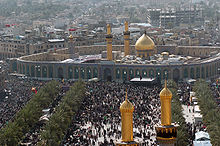- Arba'een
-

Part of a series on
Islamic culture
Architecture Arabic · Azeri
Indo-Islamic · Iwan
Moorish · Moroccan · Mughal
Ottoman · Persian · Somali
Sudano-Sahelian · TatarArt Calligraphy · Miniature · Rugs
Dress Abaya · Agal · Boubou
Burqa · Chador · Jellabiya
Niqab · Salwar kameez · Taqiya
kufiya · Thawb · Jilbāb · HijabHolidays Ashura · Arba'een · al-Ghadeer
Chaand Raat · al-Fitr · al-Adha
Imamat Day · al-Kadhim
New Year · Isra and Mi'raj
al-Qadr · Mawlid · Ramadan
Mugam · Mid-Sha'ban
al-TaiyyabLiterature Arabic · Azeri · Bengali
Indonesian · Javanese · Kashmiri
Kurdish · Persian · Punjabi · Sindhi
Somali · South Asian · Turkish · Urdu Millions of Shia Muslims gather around the Husayn Mosque in Karbala after making the Pilgrimage on foot during Arba'een.
Millions of Shia Muslims gather around the Husayn Mosque in Karbala after making the Pilgrimage on foot during Arba'een.
Arba'een (Arabic: اربعين, means "forty"), or Chelom, is one of the largest pilgrimage gatherings on earth in which over 10 million people go to the city of Karbala in Iraq.[1][2][3][4][5] As it is known by Persian-speaking and Urdu-speaking Muslims in Central and South Asia, Arba'een is a Shia Muslim religious observation that occurs 40 days after the Day of Ashura, it is observed all over the world. It commemorates the martyrdom of Husayn bin Ali, the grandson of the Prophet Muhammad which falls on the 20th day of the month of Safar. Husayn and 72 supporters died in the Battle of Karbala in the year 61 AH (680 CE), killed by Yazid's army. Chelom is also observed 40 days after the death of a family member or loved one. Forty days is the usual length of the time of mourning in many Islamic cultures.
The occasion reminds the faithful of the core message behind Husayn's martyrdom: establishing justice and fighting injustice, no matter what its incarnation—a message that strongly influenced subsequent Shi'a uprisings against the tyranny of Umayyad and Abbasid rule.
In the first Arba'een gathering in the year 62 AH, Jabir ibn Abdullah, a companion of the Prophet, was one of the people who performed a pilgrimage to the burial site of Husayn. Due to his infirmity and probable blindness, he was accompanied by Atiyya bin Saad. His visit coincided with that of the surviving female members of the Prophet's family and Husayn's son and heir Imam Zain-ul-Abideen, who had all been held captive in Damascus by Yazid I, the Umayyad Caliph. Imam Zain-ul-Abideen had been too ill to participate in the Battle of Karbala. He later devoted his life to Azadari and spreading the message of Imam Hussain's supreme sacrifice.
The city of Karbala in Iraq, the third holy place of Shia Islam, is the center of the proceedings where, in a show of humility, many crawl through the streets of the city while others fall on their hands and knees as they approach the Shrines of Husayn and his brother Abbas ibn Ali. Many pilgrims travel miles on foot to reach Karbala.
Observance of Arba'een in Karbala was banned for many years when Saddam Hussein, was president of Iraq. For nearly 30 years under Saddam's regime it was forbidden to mark Arbaeen publicly in Iraq. Following the 2003 invasion of Iraq, the observance in April 2003 was broadcast worldwide.[6]
In 2008, approximately nine million religious observers converged on Karbala to commemorate Arba’een.[7] However, in 2009, the number of people visiting Karbala on Arba'een significantly increased. According to the official website of BBC News and Press TV (Iran), over ten million people had reached the city of Karbala one or two days before Arba'een. The number of pilgrims was expected to rise to 14 million during the next two days.[8][9]
Muslims from the Ahli Sunnah wal Jamaah, however regard the observance of Arba'een and many of it's accompanying rituals as Innovations in Islam or Bid'aa in Arabic. This term usually means any ritual or belief incorporated into Islam that was not observed or practiced personally by the Prophet Muhammad (peace be Upon him) in his lifetime. Islam is founded on the holy book The Quran and the extensive and in-depth teachings of the Prophet Muhammad, usually referred to as the Sunnah. As such, the forty days mourning period for family members and loved ones observed by some Muslims and which is influenced by the Arba'een, also falls into this category of Bid'aa or Innovation. Bid'aa or innovations are banned from Islam by a Hadith of the Prophet Muhammad discouragiing their adoption and emphasising the need and importance to stick to his teachings and traditions.
Contents
Use in political protest
Arba'een has sometimes been used as a political protest, at least in Iran. It was first used there to protest the killing of supporters of Ayatollah Khomeini in Qom on June 5, 1963 when a general strike was announced. A cycle of Arba'een public observance of mourning rituals of martyred protestors — where an arba'een public observance/demonstration was held to commemorate protesters killed in the preceding Arba'een protest demonstration — is often credited as part of the reason for the success of the Iranian Revolution in overthrowing the shah in the 1978-78,[10] although that explanation has also been questioned.[11]
Arba'een in the Gregorian calendar
While Arba'een is always on the same day of the Islamic calendar, the date on the Gregorian calendar varies from year to year due to differences between the two calendars, since the Islamic calendar is a lunar calendar and the Gregorian calendar is a solar calendar. Furthermore, the method used to determine when each Islamic month begins varies from country to country (see Islamic calendar).
- 2005: March 31
- 2006: March 21
- 2007: March 10
- 2008: February 28
- 2009: February 15
- 2010: February 5
- 2011: January 25
See also
- List of largest peaceful gatherings in history
Notes
- ^ "El Paso Inc". El Paso Inc. http://elpasoinc.com/readArticleNYT.aspx?guid=04734d5d-49a1-edce-78a3-89dd4b6ccada. Retrieved 2010-06-30.
- ^ uberVU - social comments (2010-02-05). "Friday: 46 Iraqis, 1 Syrian Killed; 169 Iraqis Wounded - Antiwar.com". Original.antiwar.com. http://original.antiwar.com/updates/2010/02/05/friday-46-iraqis-1-syrian-killed-168-iraqis-wounded/. Retrieved 2010-06-30.
- ^ Aljazeera. "alJazeera Magazine - 41 Martyrs as More than Million People Mark 'Arbaeen' in Holy Karbala". Aljazeera.com. http://www.aljazeera.com/news/articles/34/41-Martyrs-as-More-than-Million-People-Mark-Arbae.html. Retrieved 2010-06-30.
- ^ "Powerful Explosions Kill More Than 40 Shi'ite Pilgrims in Karbala | Middle East | English". .voanews.com. 2010-02-05. http://www1.voanews.com/english/news/middle-east/Blast-Kills-27-in-Iraqi-Shiite-City-of-Karbala-83628687.html. Retrieved 2010-06-30.
- ^ Hanun, Abdelamir (2010-02-05). "Blast in crowd kills 41 Shiite pilgrims in Iraq". News.smh.com.au. http://news.smh.com.au/breaking-news-world/blast-in-crowd-kills-41-shiite-pilgrims-in-iraq-20100205-nivg.html. Retrieved 2010-06-30.
- ^ Vali Nasr, The Shia Revival. New York: Norton, 2006; pp 18–19.
- ^ Official website of Multi-National Force - Iraq
- ^ BBC News - In pictures: Arbaeen in Karbala
- ^ Press TV - 10 million pilgrims commemorate Arbaeen
- ^ Kurzman, Charles, The Unthinkable Revolution in Iran, Harvard University Press, 2004, p.54-5
- ^ Kurzman, The Unthinkable Revolution in Iran, (2004), p.57
External links
- ARBAEEN by Mahmoud Ayoub, an article from the Encyclopædia Iranica
Muslim holidays and observances The two Eids Other holidays and observances 1 Shia Muslim only Categories:- Shi'a Islam
- Islamic festivals
- Shi'a days of remembrance
- Hussein ibn Ali
Wikimedia Foundation. 2010.
